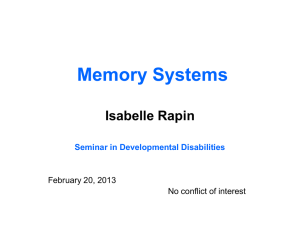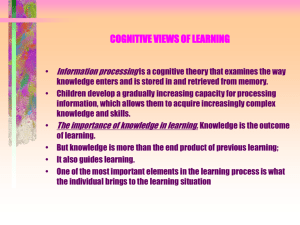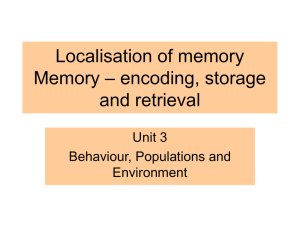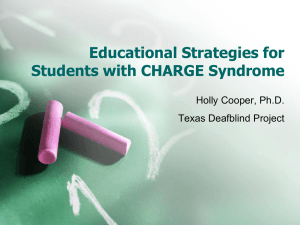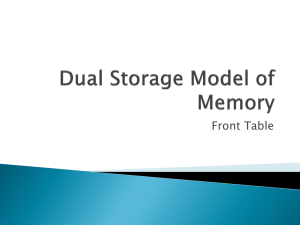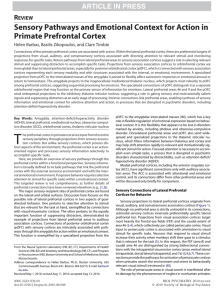Executive skills IR Mar 21 2013
advertisement
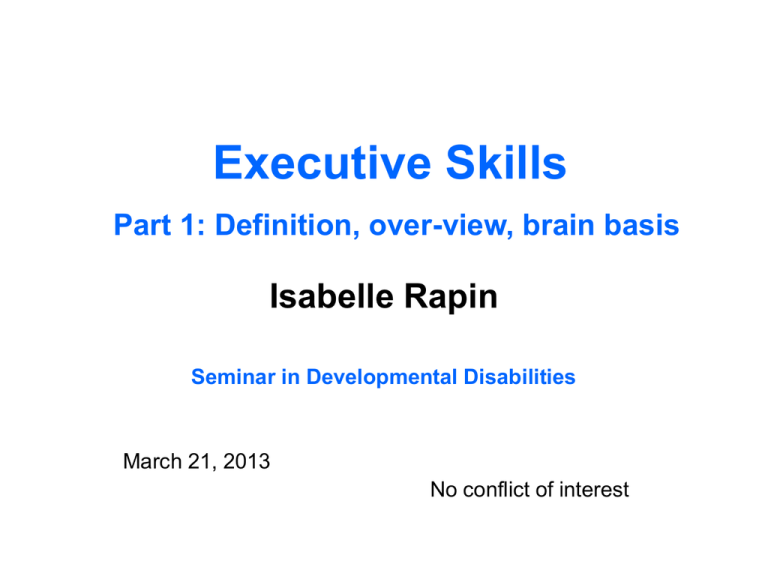
Executive Skills Part 1: Definition, over-view, brain basis Isabelle Rapin Seminar in Developmental Disabilities March 21, 2013 No conflict of interest NIH Tool Box Definition* Neurology March 12, 2013: S54-64 Executive function (cognitive control) = topdown cognitive modulation of goal directed activity • Set shifting Lateral prefrontal, anterior cingular, inferior parietal network • • Attention and inhibitory control (visual) Frontal eye fields, posterior parietal, anterior cingulate, thalamus, basal ganglia network Working memory Prefrontal, posterior parietal network * Tests for uniform research projects Definition Top-down executive/control system(s) -enable(s) endogeneously-generated goaldirected behaviors Some on-line requirements: • • • • • • • Planning (awareness of the future) Motivation Cognitive/behavioral flexibility (shifting) Selective/focused attention Inhibition of automatic sensory/affective responses Sustaining active working memory Exploit long-term memories (learning) 1. Schema of STM systems Short Term Memory Sensory buffers Working memory Sensory cortices Prefrontal cortex LTM declarative systems Long term memory Declarative (explicit,items)) Episodic (individual) Semantic (knowledge) Non-declarative (implicit skills, etc) Several subtypes More requirements Awareness of problem to be solved Advance planning Self-awareness, -monitoring Meta-cognition/multi-tasking Self-control, delay gratification Attend to feedback, shift accordingly Executive function: slowly maturing Requires repeated experiences to develop Modular aspects • Visuo-motor • Sensori-motor • Verbal • Implicit/social Considered “mature” @ start of 3rd decade Actually continues to develop life-long Susceptible to decay: dementia, frontal damage Brodmann map in color Brodmann (1909) 52 histologically distinct cortical areas Prefrontal cortex Gross anatomo-functional approximations (most functions are not localized) Dorso-lateral prefrontal ~ area 48 working memory Orbito-frontal ~ areas 10, 11, 47 inhibitory Mesial prefrontal ~ areas 8-11, 13, 32 limbic Scott, Schoenberg Developmental disorders with prominently affected executive skills ADHD (attention deficit hyperactivity disorders) ASD (autism spectrum disorders) Conduct disorders Etc. Attention - Definition Presupposes vigilance (RAS) Ability to make choices among a myriad of competing stimuli in order to match task demands by • Enhancement of attended stimuli • Suppression of unattended stimuli Requires executive skills (prioritize, etc.) “ working memory Overlaps with attention Control of attention Exogenous (reflexive, bottom-up – does not require conscious awareness) Endogenous (cortical, top-down choices to match on-going needs) • Monitor & maintain goal directed activities • Deactivate inappropriate tasks • Prepare activation of relevant tasks • Modulation by on-going affective signals Major anatomic circuitry Subcortical areas (multiple neurotransmitters) • Midbrain (ascending RAS, raphé, etc.) • Intralaminar nuclei of thalamus • Diencephalon, caudate Cortical areas (right dominant > left) • Inferior parietal – multimodal sensory processing • Lateral prefrontal - working memory, executive • Anterior cingulate - interface cognition & emotion ADHD ↓ sustained attention → distractible ↓ working memory → forgetful ↓ response inhibition → impulsive ↓ input inhibition and response monitoring ↓ awareness of affective signals & environmental rewards Autism Rigidity, narrow focus, perseveration Impaired awareness of social/ environmental cues But • Selective/focused attention may be OK • Inhibition of irrelevant sensory inputs may be • OK Memory (working and long-term) may be OK Overlaps with memory Multiple Memory Systems Short term memory systems • Sensory buffers (for each modality + • endogenous inputs from memory) Working memory Long term memory systems • Declarative (or explicit) • Non-declarative (or implicit) Retrieval systems 1. Schema of STM systems Short Term Memory Sensory buffers Working memory Sensory cortices Prefrontal cortex Working Memory Circuitry Prefrontal cortex: in continuous on-line reciprocal connections with • Sensory cortices for each modality (specific buffers) • Limbic circuits • Arousal circuits • Motor output circuits *** Note: Hippocampus circuitry: (data from amnestic patients) • • Not critical on-line, Critical for long term storage LTM declarative systems Long term memory Declarative (explicit,items)) Episodic (individual) Semantic (knowledge) Non-declarative (implicit skills, etc) Several subtypes Declarative (explicit) LTM 1. Episodic (Tulving) Uniquely human Powerful tool Specific particular facts/events (autobiographical) Late to develop evolutionarily (man only?) and ontogenitically (infant amnesia) Fragile to degeneration Critically dependent on (not limited to!) hippocampal/medial temporal cortices Declarative LTM Memory 2. Semantic Memory Knowledge (as opposed to remembrance of specific facts) “Picked-up” knowledge Starts at birth, long before episodic memory Broad and powerful Much more resilient than episodic memory Hippocampus system Binds inputs from all sensory modalities with limbic and prefrontal executive inputs Reciprocally connected with relevant cortical and subcortical circuitry Required for declarative LT memory • For fresh and midterm declarative memories • Not for very long term “ “ Not required for non-declarative memories Executive Skills Part 2 Puja Patel Seminar in Developmental Disabilities March 20, 2013 No conflict of interest
